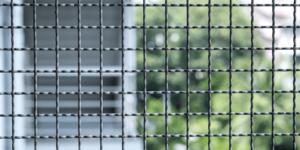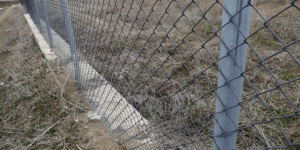Wire mesh is a multi-faceted fabric; this fabric is made with interlocking metal wires that form a grid pattern. The resource is quite often applied in many arenas, like construction, agriculture, and manufacturing. As an integral part of livestock systems, wire mesh is a key component for maintaining the health and welfare of animals on the farm.
The fact that we are not putting too much emphasis on the part played by the wire mesh in livestock management cannot be underscored. It acts as the emblem of disease-free stock and closed breeding areas, being able to protect them from trespassers as well as potential predators. Besides that, wire mesh gives ventilation, and even light can be let into the building, which can offer livestock a suitable living environment. Furthermore, it is robust and durable, which makes it a good companion for the building of an operational infrastructure under the harsh conditions of agricultural work.
The purpose of this article is to illuminate how the different grades of wire mesh and their characteristics are essentially dissimilar.
There are various grades of wire mesh in the market, and each type uniquely differs from the other and, therefore, can be used specifically in certain applications. A second very used wire mesh, commonly referred to as heavy-duty wire mesh, is comprised of larger gaps and thicker wires. Actually this is the classy of the wire mesh used in livestock and wild beasts enclosures where is strength and durability important.

Wire mesh that consists of medium-grade wire falls in the category of coarse wire mesh and fines in terms of wire thickness and opening size. It is called upon in livestock feeders and waterers because it is constructed of resilient materials with alstaingales, which allow animals to have easy access to feed or water.
The stretched wire mesh has smaller holes and thinner wires than regular wire mesh. Generally, it is exercised to guard the livestock against insects and predators that may pose health and safety risks. Bees, in this case, use the fine wire mesh to prevent wasps from entering. It is a good example of utilizing the bees for the welfare of fellow creatures.
The varieties of polymer grades are not limited to these common ones, as other meshes are also available for customized livestock handling reasons. These grades might act as tailored qualities such as high flexibility as well as resistance to corrosion.
Use of Coarse Wire Mesh in the Construction of Livestock Fences and Enclosures is Among its Many Uses
Mesh made of the coarsest wire is commonly used in the construction of fences and enclosures all around the world because of its triteness and hardiness. It allows animals to be enclosed and protected against the possibility of escape as well as attracting prohibited animals that are not predators. The wide spaces found in the coarse wire mesh enable farmers to look at their animals; thus, they can do their monitoring.
Ranchers use rough wire mesh to make livestock enclosures for cattle pens, horse paddocks, and sheep enclosures. Such enclosures involve the use of durable and strong fencing that can prevent animals from getting outside or breaking out of the enclosure. The tough wire mesh is strong enough to resist the pressure from animals, which may fall on the fence and cause it to crack or even break.
Medium Grade Wire Mesh in Livestock Feeders and Waterers: Benefits
Low grade wire mesh is very suitable for feeders and waterers of livestock as it can bear heavy loads and yet is still able to function conveniently for the animals. It has good holding power and carries weight without sinking or bending.
One of the medium-grade wire mesh benefits in livestock feeders is the effectiveness in eliminating waste of feed. The smaller openings of this specific grade of wire meshes prevent the animals from spilling or scattering their feed. Hence, the farmers do not incur a lot of waste and save on their costs.
As with high-grade wire mesh, medium-grade wire mesh is also widely utilized for livestock waterers. Its strength and durability enable the set up of waterers that can withstand the pressure binding animals and still provide reliable enough water sources for animals.
Fine-Mesh Wire-form and Its Contribution to Preventing Livestock from Insects and Predators
The fine wire mesh is of ultimate importance in keeping insects and predators that want to harm livestock away from animal health and safety. The little openings in this grade of wire mesh bring about a situation where, for instance, flies, mosquitoes, and bees cannot enter livestock enclosures.
Moreover, fine wire mesh is a useful tool to keep insects as well as foxes, raccoons, and raptors out. It brings about the establishment of a safe space where the animals are protected from any attacks and, thus, are kept secure.
The livestock enclosures such as poultry houses, aviaries, and beekeeping operations are generally secured with fine wire mesh. The animals living here need special protection against dangerous insects and carnivores that could cause injury to animals or interfere with their natural behavior.
These specific grades of metal wire mesh are used to transport and manage livestock.
Moreover, next to the common wire mesh grade, there is a specialized category of wire mesh designed to meet more demanding situations connected with animal handling and transport. These grades, which are for the use of these specific applications, are created to be in accordance with these exact needs.
Corrosion-resistant wire mesh is also a new type of fabric that is commonly used in livestock transportation equipment, like trailers or trucks. This grade of wire mesh was created to tolerate exposure to water and other corrosive elements so that it stays in the best condition for a long time without being damaged.
When selecting the most appropriate grade of wire mesh for your livestock management needs, you should consider several factors that affect the health and safety of your animals.

While choosing the suitable wire mesh grade for your livestock facility, numerous variables must be considered. Firstly, the appropriate use should be assessed. Different grades of wire mesh serve various functions, hence selecting the best one that meets your obligations is vital.
Another factor to look at is the number and type of livestock because they play an important role. Larger animals, especially those with a powerful bite or sharp claws, may require a stronger grade of wire mesh to prevent them from escaping or causing damage to the enclosure. Likewise, a finer mesh for the smaller animals may be needed to keep the insects away or prevent them from being attacked by predators.
Last but not least, necessary monetary limitations should be kept in mind. Higher wire mesh grades may provide a longer life and superior resilience, but they may also be more expensive. Minding about the quality and pricing issues is crucial for the purpose of effectively meeting your livestock management requirements.
However, in conclusion, mesh wire is one of the most essential components of livestock management because it creates a safe and comfortable space for animals. Having different grades of wire meshes, like coarse, medium, fine, and specialized, each one has a specific character and area of application.
The coarse wire mesh or the heavier gauge is preferred when it comes to livestock fencing and enclosures because it ensures that the structures are strong and durable. A medium grade of wire mesh is what fits well in feeders for livestock along with waterers because of its ability to hold weight and, at the same time, facilitate the access of animals. Microfine wire mesh is used to safeguard livestock against bugs and hunters, which guarantees their lives. Specialized wire mesh types are designed to meet the specific requirements and tasks associated with stock handling and transportation.
But when one is looking for the ideal wire mesh grade for animal management, the things to consider include application, size of animals, and budget of the person. Through the careful choosing of wire mesh grade, you can guarantee the safety and comfort of your livestock as well as increase the efficiency of your agricultural processes.
